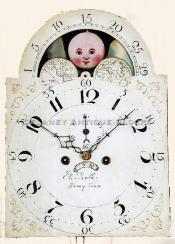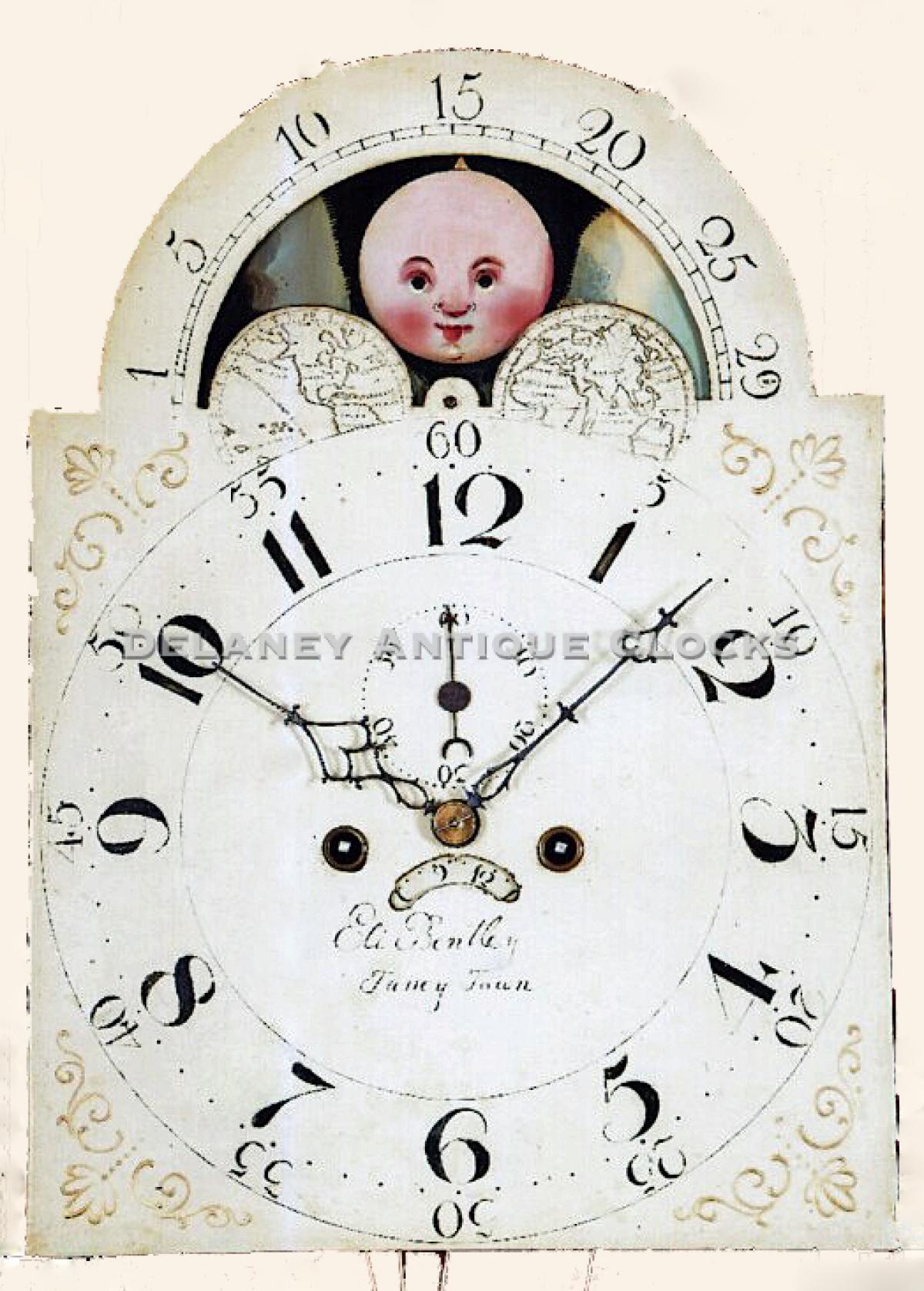Eli Bentley of Taney Town, Maryland. An inlaid walnut-cased tall clock. VV-41.
This case is constructed in walnut and is decorated with a number of line or string inlay patterns. A large circle is positioned in the base section. A double-line inlay pattern is used on the waist door. The interior rectangle of this design features a pattern that includes cut-out corners. Line patterns are used to follow the shaping of the hood and the hood door. The walnut selected for the construction of the case exhibits a number of choice grain patterns. The finish is excellent and highlights the details of the construction. This case stands on four gently flared French feet applied to the bottom of the base. The base section features a large panel. The front two corners of this base are slightly canted. The waist section is long. The front corners of this section are also canted. This off-angle surface is decorated with a double band of line inlay that runs the length of the molding. A rectangular-shaped door is centered in the waist. Through this door, one can access the interior of the case. Above the door is a decorative strip of figured walnut. The bonnet is a swan's neck form. The arches are nicely formed and exhibit good height. These terminate in carved floral designs and help evenly space the three turned wooden finials. The finials are mounted on line inlaid plinths. Please note the exposed dove-tail detail on the sides of the hood. Fully turned bonnet columns flank the arched glazed door. This door opens to a painted iron dial.
This colorfully painted iron dial was locally made here in America by the Jones dial painting firm in Pennsylvania. The hours are indicated with large Arabic figures. Arabic numerals are also used in the five-minute locations. This clock features a subsidiary seconds hand and dial. A day-of-the-month calendar is located in the traditional location below the center arbor. In the arch of this dial is a moon phase mechanism or lunar calendar. This tracks the moon's age throughout twenty-nine and a half days. The four spandrels areas are decorated with raised gesso work that is highlighted with gilt paint.
The time and strike movement is brass, eight-day duration, and of good quality. It is constructed in brass and is weight powered. This clock will also strike each hour on a cast iron bell. The bell is mounted above the movement. It is interesting to note that the Maker signed the seat board, "Eli Bentley Jan. 29.1816." I am assuming that this is the clock's completion date.
This clock was made in 1816. The case stands approximately 8 feet tall to the top of the center finial. It is 19.74 inches wide and 10.25 inches deep.
Inventory number VV-41.
Eli was born on February 16, 1752 in Concord, Pennsylvania. He was the third child of Joseph Bentley, the tavern keeper of the Red Lion Tavern in Doe Run, Pennsylvania. At age twenty, he married Mary Hunter who was the first cousin of clockmaker Thomas Shields. He soon bought a home at West Whitelands, near West Chester, Pennsylvania and made clocks there from about 1778 to 1787. It is said that clocks were not in demand during the Revolutionary War, so Eli and his brother caleb became silversmiths. (It is recorded that MESDA owns one piece each of silver signed by Eli Bentley and his brother Caleb.) In 1787, Eli bought a lot in Taney Town, but the exact date his family moved there is unknown. In 1790, the year of the first census, Eli Bentley and eight family members were registered in Taney Town. Here he made clocks and repaired them until his death in 1822 at age of 70. Major Alexander McIlhenny of Uniontown bought clock works from Bentley in 1817 for $60, then paid cabinetmaker George Christ an additional $40 for a case. This was a huge investment at the time – an indication of McIlhenny’s wealth. Most makers left their names somewhere on the faces of their clocks, but sometimes they appear elsewhere – even on the pendulums. Identifying the cabinetmaker who built the housing can be more difficult. His clocks ranged from simple thirty-hour single weight clocks to ornate eight day clocks with sweep second hands and moon dials. His brother Caleb and Jacob Kuhns were administrators of his estate.
It is said that he made in excess of fifty tall clock examples in his lifetime. As a result, he is considered to be Carroll County’s best-known craftsman of the period. As a maker of clocks, his examples are highly prized possessions for those lucky enough to own them. The Carroll County Historical Society is proud to have five examples in its collection. Additional clocks are pictured in several Horological reference books. A fine example fitted with a composite brass moon phase dial is pictured in Pennsylvania Clockmakers, Watchmakers and Allied Crafts written by James Biser Whisker.






